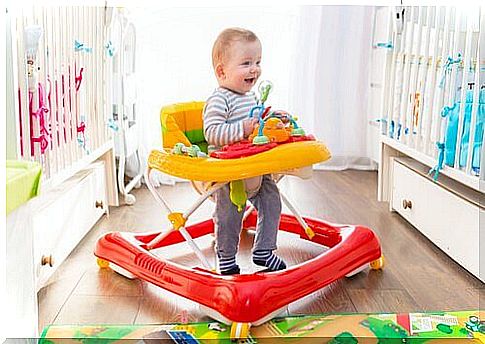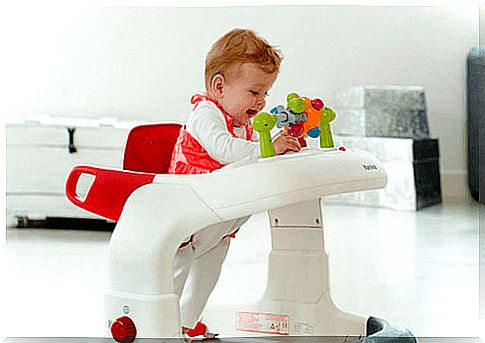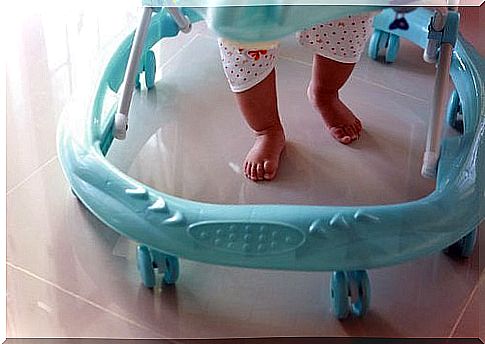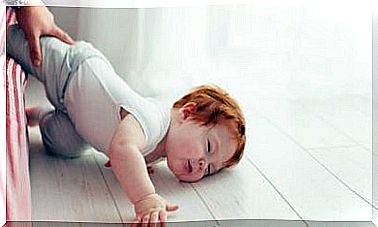Advantages And Disadvantages Of A Walking Chair When A Child Learns To Walk

A walking chair is a chair-like aid in which a child learning to stand and walk is supported so that his or her feet touch the floor. This allows the child to strain the speed of the floor with their feet. Using a walking chair is like an intermediate form of crawling and walking. What are the pros and cons of a walker, and what are the effects of this aid on a small child?
The walking chair supports the child and prevents it from falling, in addition to which the small rings of the chair allow the child to move freely. However, excessive use of this aid can affect a child’s motor development.
The benefits of a walking chair as a child learns to walk
The walking chair gives the child a sense of independence
Parents monitor each movement of the child as he or she begins to crawl and practice walking. Such protection in its own way restricts the child’s movement and independence.
When learning to crawl and walk, the child needs to be allowed to move safely. When he uses a walking chair, his parents do not have to watch and help him at all times, but he is able to be and move more freely.
A walking chair gives parents time for other activities
One reason to use a walker is that moms and dads need time to do different jobs and tasks. It is important that parents have the opportunity to do other things in addition to childcare so that caring for a child does not become an overwhelming task.
When the child is sitting safely in a walker, the parent is able to perform household chores or other things.
Fun and entertainment for the child
The walking chair is like a toy for a child. A growing child can have fun in the chair for hours as they experience their first steps and the joy of moving. Walking chairs are often bright and attractively colored, with a variety of toys and items attached to them to entertain the child.
Some walkers also act as activation centers to complement a child’s learning. The chairs integrate a variety of colors, shapes, tones and textures that make them attractive to a child’s eyes. Working with such tools affects a child’s cognitive development.

Disadvantages of a walking chair when a child learns to walk
The walking chair does not develop the child’s ability to walk
Contrary to popular belief, the use of a walker does not stimulate a child’s ability to walk. When using a walking chair, the child receives artificial help, in which case no movement he performs is comparable to the actual walking.
In other words, using a walker does not challenge the child enough to control their movements. This aid supports the child’s weight, leaving the walking experience incomplete. According to some theories, using a walker can even cause distortion.
While there are also benefits to using a walker, a child will not learn to walk just by using a walker. The child’s leg muscles do work, but with assistance.
If you decide to buy a walker for your family, you should use it reasonably. The child should not be left in the chair for a long time and the chair should not be used too often. While placing a child in a stroller allows parents to focus on other matters, excessive use of the chair is harmful. The child must be allowed to practice walking even without aids.
Using a walker can cause a delay in crawling and walking
The transition from crawling to walking takes place at the very moment when most parents take up the walking chair. It’s good to remember that while a child’s movements are a little awkward, they are an important part of a child’s motor development.
Placing a child in a walker can delay learning to walk and even interfere with the child’s development. It is important for parents to allow the child to experience each stage of development properly and to face all the milestones of development. Walking is not just about mobility but also about muscle development.

The walker prevents falls, which are an important part of a child’s development
No parent wants their child to fall or hurt themselves as he or she takes his or her first steps. However, falling to a certain point is an important part of a child’s development.
It is true that a fall can happen, and in its own way it represents danger and loss of control. However, it is an experience that allows a child to learn about their environment and gravity.
A walker alone is not a problem, but overprotecting a child is also a challenge for many parents. Some parents are afraid to let go of the child and let him walk by himself.
Parents must, of course, make sure that the environment is safe for the child and watch for it insensitively. However, the child must have the opportunity to learn to walk naturally and thereby increase self-confidence in the new skill.
In summary, the use of a walker can have an impact on a child’s development. However, it is not dangerous to let a child sometimes have fun using a walker.









